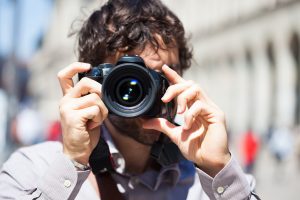Seeing the World Through Photographs: Using Photography as a Conversation Tool in English Class


“There are always two people in every picture: the photographer and the viewer.”
—Ansel Adams (1902–1984), American photographer and environmentalist
If a picture is worth a thousand words, what are they? How can we use photographs as a conversation tool in our English classrooms?
Photographs capture a moment in time, significant or insignificant. Many people enjoy taking pictures of new places and strange sights while traveling. Some photographers also enjoy taking pictures of their own city and surroundings. These types of photos are often awe-inspiring and provoke a response easily when shared over social platforms like Instagram. Yet getting ESL and EFL students to talk about photography can be more difficult than many suspect.
Some photographs – often candid and documentary photos – can sometimes provide the best conversations. Street photography, a somewhat controversial practice, focuses on taking pictures of people in public places without permission at “the decisive moment.” These photographs can capture dramatic, unplanned moments and document social situations. Street photographs can be very powerful for this reason; they seem to capture a slice of reality. These unscripted photographs can engage international students, especially if they are trying to better understand their new surroundings.
“I prowled the streets all day, feeling very strung up and ready to pounce, determined to ‘trap’ life—to preserve life in the act of living.”
—Henri Cartier-Bresson (1908–2004), French photographer
People walking on a street, playing in a park, going to work on a train, or relaxing on a beach might be subjects for a street photographer. Individuals such as Eugene Atget, Henri Cartier-Bresson, Robert Frank, Harold Feinstein, and Daido Moriyama have won great praise for their candid street photography. People often enjoy people watching, and street photography captures people moving and talking in public.
Yet the practice—and legality—of street photography continues to be debated. Different countries often have very different laws. Some people think of street photography as free speech, but consider it rude. Others see it as an invasion of privacy. For instance, paparazzi – street photographers in their own right – sometimes photograph celebrities and their families without permission and sell these photographs for money. Celebrities often want their privacy, especially for their children, but they have also chosen to become famous. Does this make the actions of the paparazzi acceptable?
These varied opinions on street photography make for excellent talking points in the English classroom. You can ask your ESL students the following questions to get them started:
1. Why do street photographers take pictures of people in public?
2. How would getting permission before taking pictures change street photography?
3. When do you think photographers should get permission to take photographs of people in public? Why?
4. Do you think paparazzi should take natural pictures of celebrities in their daily life? What about pictures of a celebrity’s child?
5. By the way, how do you think your knowledge of the world be different if photography didn’t exist?
Additionally, I have found that using photo exercises in class provides many opportunities for compelling conversation. Once separated into small groups, I have the students examine a photograph related to the lesson and give them a series of questions to discuss. How would you describe this person? What do you like about this photo? What do you think happened a minute later? How do you think the main subject feels? Why? These questions require the student to analyze all components of the photo and their real world implications. They can also use their own photographs from their smart phones!
By the way, while I have only used photography as a conversation tool in advanced English classes, I can imagine photography could be quite effective in beginning and intermediate English classes too. You could review colors, feelings, nouns, verbs, verb tenses, and adjectives. Street photography, again, seems much more appropriate and authentic to me than staged fashion pictures or advertising images that seem project a “should” element on how we “ought to” look or behave. Street photography, in contrast, focuses more on how we actually do look and behave in public.
Below is a Search and Share exercise I created for this particular subject for advanced English students. Feel free to share it with your own ESL and EFL students!
SEARCH and SHARE: Documenting Moments in Time
Student Name: ………………………………………………. Date: ……………………………..
Class: ………………………………………………………….. Teacher: ………………………….
Documentary photographs capture important moments in time. Visit the Library of Congress collection to find a special historical photograph that captures your imagination. Print it out and share it with your classmates.
Title: ……………………………………………………………………………………………………..
Photographer: ………………………………………………………………………………………….
Historical Context: ………………………………………………………. Date: ……………….
1. Describe the photograph. What is going on?
2. How did the photographer compose his picture? Where are your eyes drawn?
3. What historical moment does it capture? Does it do it well?
4. Why do you think the photographer chose to take this picture?
5. Why did you choose this photograph?
6. What did you learn from it?
7. Do you think a photograph like this would still be taken today? Why? Why not?
8. On a scale of 1–5, with 5 being the highest, how would you rate the photograph? Why?

Do you use photography and other visuals as conversation pieces in your English classroom? What exercises or techniques work best for you when discussing them as a class? Do you encourage students to share their photographs? Why? Why not? Consider me curious!
For more on street photography, click the links below:
- http://facweb.cs.depaul.edu/sgrais/street_photography.htm
- https://www.youtube.com/watch?v=Z2r0J1kE6-8
For more Search and Share activities from Compelling Conversations – Japan like this one, visit here. And be sure to check out this Search and Share collection from Compelling American Conversations, now available on Teachers Pay Teachers!
Ask more. Know more. Share more.
Create Compelling Conversations.
Visit www.CompellingConversations.com


